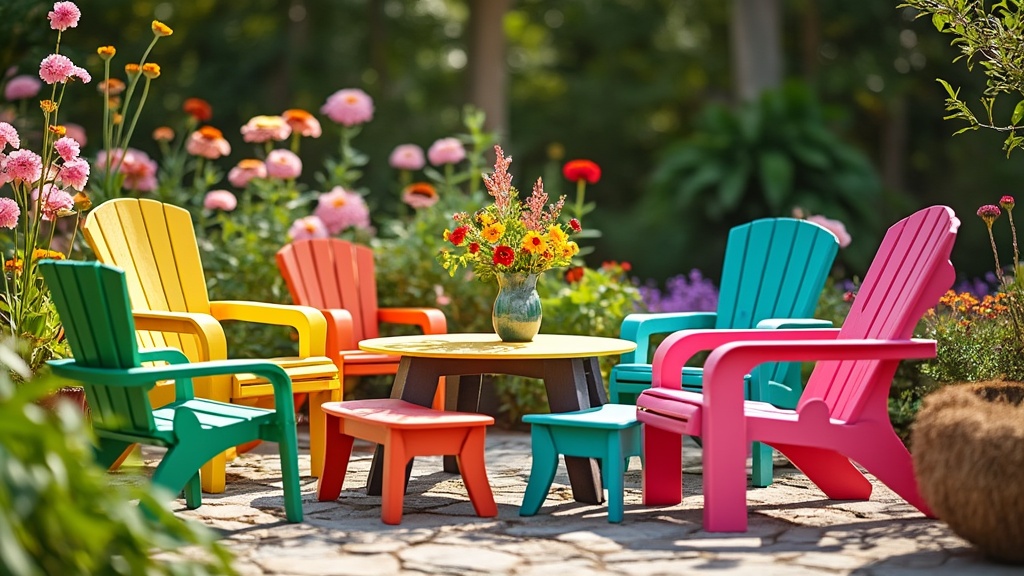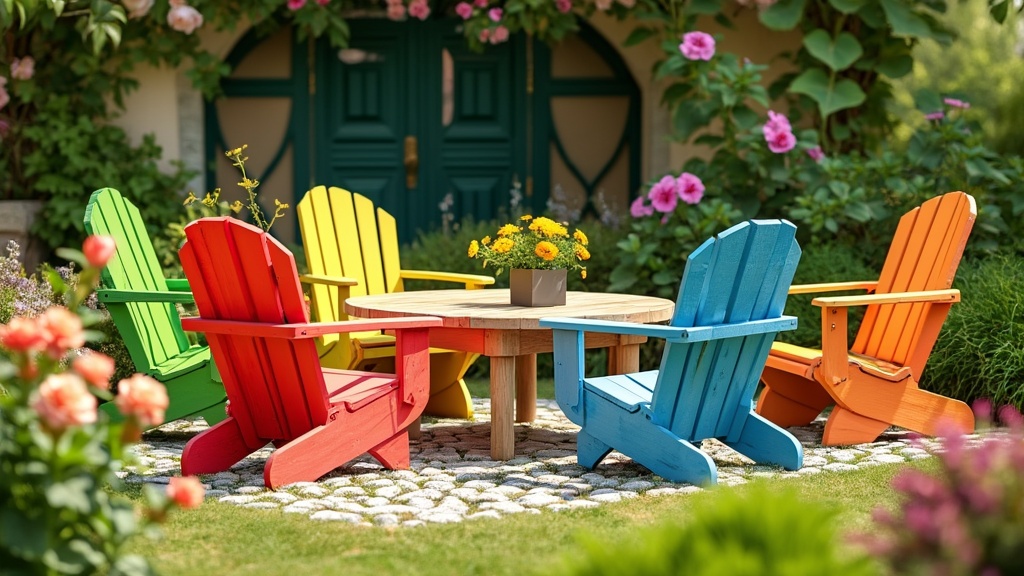Embracing furniture recycling not only enhances the environment but also sparks creativity within your home. By reimagining discarded pieces, you can achieve both functional benefits and aesthetic appeal.
Adopting sustainable practices significantly reduces landfill waste, promoting environmentally friendly living.
These innovative projects allow individuals to transform old items into chic home decor, merging sustainability with style.
So, whether you’re feeling crafty or simply looking to declutter, recycling initiatives can motivate you to create unique furnishings from what you already have.
Click here to learn more about: interior designers and decorators
Upcycle Old Furniture For New Life
Exploring the art of upcycling opens up a world of possibilities for your old furniture. By transforming chairs or tables, you effectively contribute to waste reduction while creating something new.
Consider starting small with projects, such as:.
- Turning an old chair into a plant stand: Clean, paint, and repurpose the piece to breathe new life into your space.
- Customizing dressers: Create unique storage solutions that reflect your personal style.
- Crafting a coffee table from crates: Use salvaged materials to create functional art for your living room.
Upcycling not only saves money but also fosters a deeper connection with your environment through creative solutions. With each project, you embrace ecoconscious living, turning secondhand treasures into statement pieces that enhance your home decor.

How To Reuse Everyday Items
Reusing everyday items serves as an effective approach to foster sustainable living. This eco-friendly practice significantly reduces waste and promotes innovative thinking.
For example, glass jars can be creatively repurposed as storage solutions or decorative vases, which enhances both organization and aesthetic appeal in your home.
By transforming these ordinary containers, you can create a unique decor that reflects your personal style while minimizing environmental impact.
Utilizing items you already possess fosters an artistic vision that resonates with your individuality, making your space feel inviting and personalized.
Creative Ideas for Reusing Items
Think about upcycling items such as:
- Old T-Shirts: Transform them into reusable shopping bags or cleaning cloths.
- Candle Jars: Clean and reuse them as storage for office supplies or kitchen utensils.
- Wine Corks: Create unique coasters or bulletin boards.
Each item possesses the potential to be repurposed into something functional, allowing for artistic expression and a distinctive house environment.
Transforming Furniture With DIY Projects
Taking on DIY projects to transform furniture presents an exciting opportunity to express your personal style. This creative process enables you to restore old pieces, breathing new life into them while practicing sustainable design. Selecting a piece to work on involves considering your skill level; gathering materials before you start is essential to ensure a smooth project.
Steps to Begin Your DIY Furniture Project
- Choose Your Piece: Look for furniture that matches your skill level; thrift stores often have great finds.
- Gather Materials: Collect all necessary tools, paints, or finishes before starting.
- Select Techniques: Consider methods like painting, distressing, or upcycling for stunning results.
Adding new hardware can instantly enhance the charm of any furniture, making it not just functional but also a unique statement piece in your home. Engaging in this process allows for functional art that reflects personal creativity and contributes to eco-conscious living.
Reusing Everyday Items
- Reusing items can reduce waste by up to 50%, significantly lowering the amount of trash sent to landfills.
- Upcycling can save approximately 5 tons of CO2 emissions for every ton of material repurposed.
- DIY furniture projects can increase the lifespan of furniture by an average of 10 years, promoting sustainability.
- Creative reuse of materials can lead to cost savings of 30% or more compared to buying new items.
Restore Vintage Charm In Your Home
Embracing vintage charm can significantly connect your home to its historical roots. Vintage decor pieces serve not only as conversation starters but also enrich your living space with unique character and nostalgia.
By incorporating historical elements, homeowners can reflect their personal stories, transforming each room into a canvas filled with cherished memories.
Vintage items promote sustainability by encouraging reuse and reducing waste.
Consider exploring local vintage shops or flea markets for unique finds that add depth to your home’s aesthetic. Some thrift finds hold stories waiting to be told, transforming your living environment into a tribute to heritage and style.
Here are a few tips to restore vintage charm effectively:
- Seek secondhand treasures that resonate with personal experiences.
- Blend old furniture makeovers with modern design for a chic look.
- Utilize craftsmanship from local artisans to enhance authenticity.
Creative Decor Ideas With Salvaged Materials
Exploring creative decor ideas with salvaged materials opens a world of innovative potential. Salvaged items introduce a one-of-a-kind aesthetic, enriching visual interest through their unique textures and histories. By combining different materials, such as reclaimed wood and vintage metal, striking contrasts elevate your decor. Each piece can serve as a functional art statement that promotes sustainable design practices.
Consider the following techniques:
- Upcycle old furniture into modern vintage statement pieces.
- Repurpose salvaged materials to create multifunctional furniture.
- Engage in DIY projects that showcase your artistic vision.
“Using salvaged materials not only enhances the beauty of your home but also tells a story of resourcefulness and creativity. ”
Exploring community workshops can inspire innovative ideas on integrating salvaged materials effectively into your decor. With a focus on ecofriendly solutions, transforming your space with discarded treasures can lead to a beautifully curated home that celebrates both artistic expression and sustainability.
Vintage Charm and Salvaged Materials
- Vintage decor can increase the value of a home by appealing to buyers who appreciate historical aesthetics.
- Upcycling and repurposing materials can reduce landfill waste by up to 70%, promoting environmental sustainability.
- Incorporating local artisan crafts supports the economy and fosters community connections.
- Homes with unique vintage elements often have a lower carbon footprint due to the reuse of existing materials.
Sustainable Design With Reclaimed Wood
Reclaimed wood embodies a perfect blend of sustainability and beauty, sourced from old structures like barns and warehouses. Utilizing reclaimed wood not only promotes waste reduction but also offers unique textures and histories that enhance any design project.
Its durability often surpasses that of newly sourced lumber, thanks to the natural aging and treatment techniques applied over time.
When considering reclaimed materials, always seek local suppliers or businesses, fostering community support and reducing transportation emissions.
Incorporating reclaimed wood into your home represents an ecofriendly solution that adds character while minimizing your environmental footprint.
What Are Ecofriendly Solutions For Furniture
The demand for ecofriendly furniture options is on the rise, reflecting a growing emphasis on sustainable choices. Brands increasingly prioritize sustainable manufacturing processes, utilizing materials like reclaimed wood and bamboo to create stylish and functional pieces.
These innovative designs not only reduce landfill waste but also contribute to healthier indoor environments by minimizing pollutants. Researching brands with certifications like FSC or GOTS can ensure their commitment to conscious consumerism.
By integrating ecofriendly furniture into your home, you support a circular economy that values creativity and environmental stewardship.
Some key features to consider include:
- Use of salvaged materials for distinctive style.
- Adaptive reuse techniques in furniture design.
- Commitment to functional art that fits in any living space.
Exploring options available through local artisans and community workshops can yield unique furnishings that speak to your artistic vision. By prioritizing ecofriendly selections for furniture, individuals participate in waste reduction initiatives that promote sustainability and enhance design creativity in their homes.
| Feature | Benefit |
|---|---|
| Use of reclaimed wood | Promotes waste reduction and offers unique textures |
| Ecofriendly furniture options | Contributes to healthier indoor environments |
| Materials like bamboo | Support sustainable manufacturing processes |
| Local artisans and workshops | Provide unique furnishings that enhance design creativity |
Innovative Ideas For Functional Art
Functional art represents a unique intersection of utility and creativity, capturing the attention of homeowners and designers in modern decor. The trend of transforming everyday items into stunning art pieces not only infuses a sense of individuality into spaces but also encourages conscious consumerism.
Here are some innovative ideas to consider:.
- Create a feature wall that highlights framed art from repurposed materials such as vintage plates, fabric swatches, and salvaged timber. This adds a personalized touch while promoting sustainability.
- Upcycle furniture by giving old pieces an artistic makeover. Consider techniques like painting, reupholstering, or adding unique hardware to breathe new life into secondhand treasures.
- Design multifunctional furniture that not only serves a purpose but also acts as a statement piece. For instance, a bench that doubles as art can enhance both aesthetics and functionality.
- Implement artistic recycling by crafting decorative items from everyday waste. DIY projects using materials like glass bottles or tin cans can turn trash into creative decor.
Collaborating with local artisans or participating in community workshops fosters a sense of connection and provides opportunities to learn restoration techniques. Vintage restoration not only safeguards history but also gives character to your decor. Embrace the philosophy of adaptive reuse to discover unique furnishings that reflect your personal style while adhering to eco-conscious principles.
By allowing your artistic vision to guide you, you can successfully merge utility with aesthetics in your home, contributing to a landscape of creative solutions and artistic expression.
- Functional art can increase the aesthetic appeal of a space, making it more inviting and personalized.
- Upcycling furniture can significantly reduce waste, contributing to environmental sustainability and promoting a circular economy.
- Collaborating with local artisans supports the community and can lead to unique, one-of-a-kind pieces that enhance your decor.
- Artistic recycling projects can save money while allowing for creative expression, transforming everyday waste into beautiful decor items.



